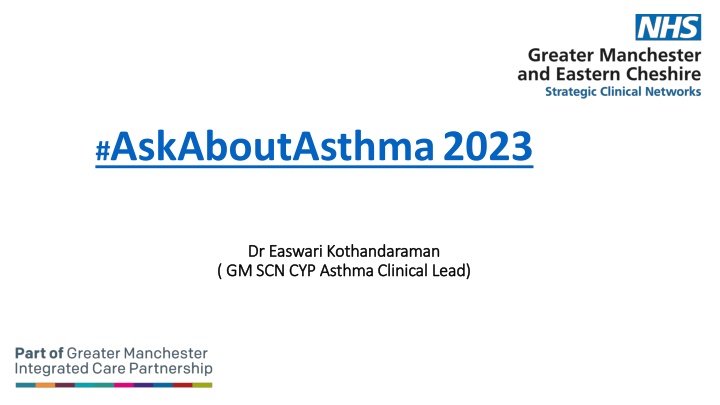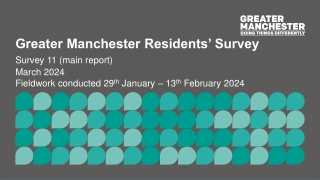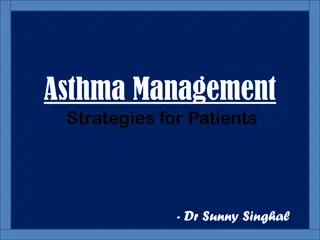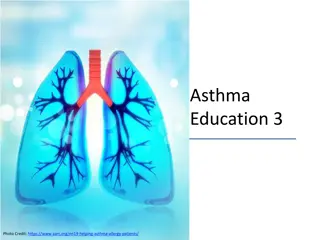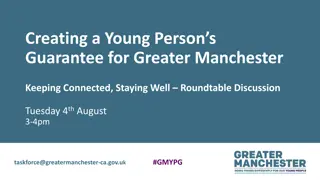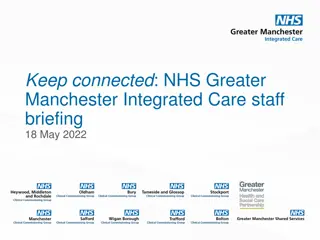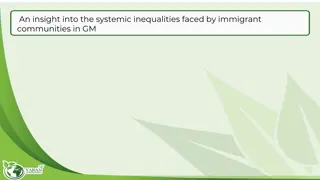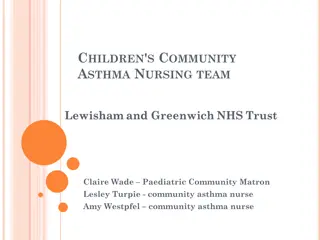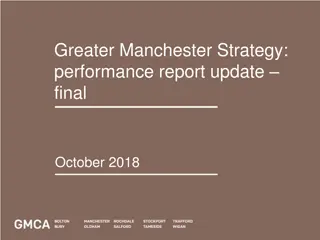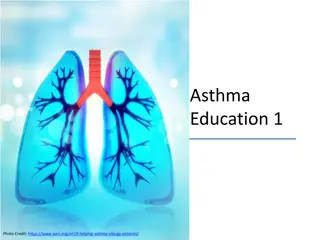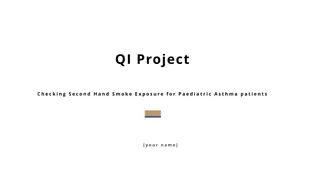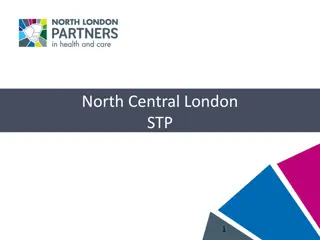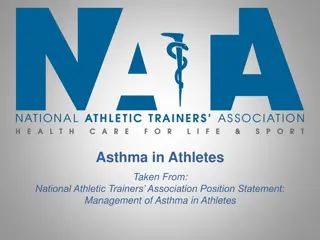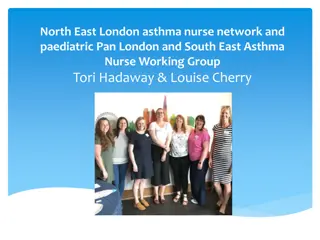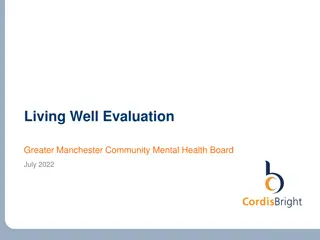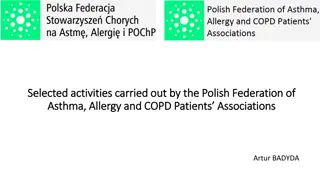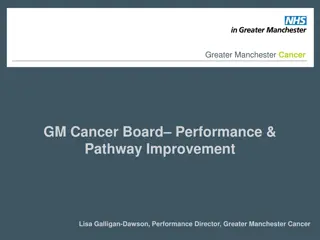Addressing Asthma in Greater Manchester: A Priority Overview
Asthma is a pressing concern in Greater Manchester, with high rates of emergency admissions and hospitalizations among children and young people. The region faces challenges related to poverty, poor housing, pollution, and health disparities. Improving care through personalized action plans is crucial to reducing asthma attacks and enhancing preventive management. Learn about the significance of Personalized Asthma Action Plans (PAAP) and the impact they have in managing asthma effectively.
Download Presentation

Please find below an Image/Link to download the presentation.
The content on the website is provided AS IS for your information and personal use only. It may not be sold, licensed, or shared on other websites without obtaining consent from the author.If you encounter any issues during the download, it is possible that the publisher has removed the file from their server.
You are allowed to download the files provided on this website for personal or commercial use, subject to the condition that they are used lawfully. All files are the property of their respective owners.
The content on the website is provided AS IS for your information and personal use only. It may not be sold, licensed, or shared on other websites without obtaining consent from the author.
E N D
Presentation Transcript
#AskAboutAsthma2023 Dr Easwari Kothandaraman Dr Easwari Kothandaraman ( GM SCN CYP Asthma Clinical Lead) ( GM SCN CYP Asthma Clinical Lead)
Why is asthma a priority in Greater Manchester? In GM, between Jan 2022 and Jan 2023, 6482 children and young people (0-19 years) attended A&E due to asthma and 1346 were admitted to hospital. In GM, Emergency admissions for CYP asthma is currently 180.1 per 100,000 population ( stratified by age, deprivation quintiles and ethnicity).Comparatively Northwest( NW) Averages at 137.12 per 100,000 . So significantly higher than rest of the NW In GM Emergency attendances at hospital for asthma for CYP is currently 907.7 per 100,000 population ( stratified by age, deprivation quintiles and ethnicity) This is much higher than National / NW average In GM CYP with Asthma getting oral steroids is much higher than National Average, reflecting poor preventive control In GM ratio of CYP with asthma receiving Rescue inhalers vs Preventive inhalers is higher than National Statistics Child of the North Report clearly articulated increased number of Children living in poverty , Poor housing, increased pollution and CYP from Ethnic minority with poor health outcomes Asthma is also one of the key conditions within the Core20PLUS5 framework for tackling health inequalities in terms of addressing over reliance on medications and decreasing the number of asthma attacks. NRAP Data for KPI from Oct 22- Mar 23 shows variability in key metrics in GM with some areas in significantly lower quintiles when compared to National Data for addressing smoking , reviewing inhaler technique and Issuing personalised action plans Each exacerbation leading to emergency attendance and admissions , leads to loss of school days in CYP , parents / carers taking time out of work all of which cuts across the community with wider impact on CYP So, Improving care and support for children and young people living with asthma is a key priority for the Children and Young People s Network
What is a Personalised Asthma Action plan? Example PAAP from Asthma UK Most of us will know about significance of PAAP in effective preventive management of CYP Asthma From NRAP data , it is clear that in some areas in GM, in CYP admitted with asthma Exacerbations only 22 % are getting PAAP , which is significantly less than National Average If a child has a personalised asthma action plan, they are four times less likely to have an asthma attack that requires emergency hospital treatment. The plan should have information on triggers; what the medicines do (preventers and relievers); how and when to take treatment; current treatment; how to spot asthma getting worse (symptoms and peak expiratory flow); what treatment to take in an emergency; how and when to call for help and how to manage indoor and outdoor air pollution. Example PAAP from Beat Asthma Parents should be encouraged to share with their child s school and any activity clubs that they regularly attend.
Importance of correct inhaler technique and Green inhalers Good inhaler technique is important in order to ensure the drug is delivered correctly and most of the medicines reaches the lungs rather than the back of the throat. Good technique is associated with less emergency department attendances. It is important to encourage children and young people to use a spacer device and healthcare professionals need to ensure the correct type is chosen Less than three-quarters of children and young people have any form of instruction in how to use their inhaler . Poor inhaler technique means patients don t get the full benefit of their asthma medication From Latest NRAP data , in some areas in GM only 19% of CYP admitted with asthma exacerbation are getting Their inhaler technique checked compared to 63% nationally . GM average of 55% is also less than National Average www.beatasthma.co.uk has videos for correct inhaler technique with appropriate spacers Traditional pressurised metered dose inhalers (pMDIs), though lifesaving, use propellant gases and are single use plastic devices that contribute to environmental pollution and global warming. Dry powder inhalers (DPIs) do not contain hydrofluoroalkane (HFA) propellants, so from this perspective have less global warming potential in comparison to traditional pMDIs. However, they still incur environmental costs in relation to their production and disposal (sometimes referred to as the life-cycle) and contain plastics that may be hazardous to the environment. Younger children (under 10) may also not be able to use them effectively, as their lungs aren t yet strong enough to breathe the medication in So it is important to consider the Green agenda when prescribing inhalers The green inhaler is the one that the CYP can and will use
Annual Reviews An annual review ensures effective management of the condition It will help us to achieve better outcomes for our CYP with asthma , reduce exacerbations , emergency presentations and admissions and reduce unnecessary use of oral steroids and over reliance on rescue / reliever medication
What is the impact of outdoor and indoor air pollution on children and young people s asthma?
We want to ensure that every asthma conversation considers the impact of outdoor and indoor air pollution on children and young people s asthma. Some key points to include in Consultations . How can we improve air quality in your home? How can we improve outdoor air quality and pollution? Do you have damp and condensation? Use background ventilation (trickle vents or whole-house mechanical ventilation) We can all do little things to help with the air quality outside. Use extractor fans and open windows o Walking or cycle to work/university/college Avoid moisture-producing activities e.g., air-drying clothes o Reduce the number of motor vehicle journeys Repair sources of water damage o Change car routes to avoid highly polluted areas and traffic How can we improve ventilation in our home? o Try to drive in a way that avoids unnecessary braking and acceleration which can help reduce the emissions Use extractor fans in bathrooms and kitchens, or open windows when: o Cooking o Using open fires or free-standing gas heaters o If possible, encourage uptake of zero and low emission vehicles o Using cleaning products, household sprays or aerosols and paints o Consider buses and trains to work or a park and ride scheme o Having a bath or shower o Air-drying clothes o Try to reduce smoking Something still not right? o Follow product instructions if using e.g., paint, glue and solvents o Ensure adequate ventilation when installing a new cooker, especially for gas cookers o Do not use gas cookers to heat a room o Avoid smoking in the house Adapted from Nice Recommendations by Eilidh Goodall UoM medical student
Would you like the air you are breathing to feel clean? Are you interested in making a difference? Look at these websites for more information on how we all can help: Friends of the Earth involved in the protection of Earth s natural environment https://friendsoftheearth.uk/ Clean Air Fund working towards a world where everyone can breathe in cleaner air https://www.cleanairfund.org/about/ Global Action Plan promotes Clean Air Day, the UK s largest air pollution campaign https://www.actionforcleanair.org.uk/campaigns/clean-air-day Living Streets campaign to tackle air pollution across the UK https://www.livingstreets.org.uk/get-involved/campaign-with-us/tackle-air-pollution
